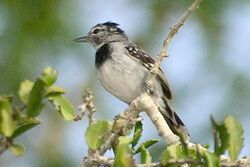Biology:Herpsilochmus
| Herpsilochmus | |
|---|---|

| |
| Pectoral antwren (Herpsilochmus pectoralis) | |
| Scientific classification | |
| Domain: | Eukaryota |
| Kingdom: | Animalia |
| Phylum: | Chordata |
| Class: | Aves |
| Order: | Passeriformes |
| Family: | Thamnophilidae |
| Genus: | Herpsilochmus Cabanis, 1847 |
| Type species | |
| Myiothera pileata[1] Lichtenstein, 1823
| |
Herpsilochmus is a genus of insectivorous passerine birds in the antbird family (Thamnophilidae). They are found in forest, woodland and shrub in South America, although a single species the rufous-winged antwren (H. rufimarginatus) also occurs in Panama. All are relatively small antbirds that are sexually dichromatic. In most (but not all) species males are essentially light grey with a black crown and black-and-white wings, while females are more buff or rufous with black-and-white crown.
The genus Herpsilochmus was introduced by the German ornithologist Jean Cabanis in 1847.[2] The name of genus combines the Ancient Greek words herpō "to creep about" and lokhmē "thicket" or "copse".[3] The type species is the Bahia antwren.[4]
The genus contains 17 species:[5]
- Ash-throated antwren, Herpsilochmus parkeri
- Creamy-bellied antwren, Herpsilochmus motacilloides
- Predicted antwren, Herpsilochmus praedictus
- Aripuana antwren, Herpsilochmus stotzi
- Black-capped antwren, Herpsilochmus atricapillus
- Bahia antwren or pileated antwren, Herpsilochmus pileatus
- Spot-tailed antwren, Herpsilochmus sticturus
- Dugand's antwren, Herpsilochmus dugandi
- Todd's antwren, Herpsilochmus stictocephalus
- Ancient antwren, Herpsilochmus gentryi
- Spot-backed antwren, Herpsilochmus dorsimaculatus
- Roraiman antwren, Herpsilochmus roraimae
- Pectoral antwren, Herpsilochmus pectoralis
- Large-billed antwren, Herpsilochmus longirostris
- Yellow-breasted antwren, Herpsilochmus axillaris
- Rusty-winged antwren, Herpsilochmus frater
- Rufous-margined antwren, Herpsilochmus rufimarginatus
References
- ↑ "Thamnophilidae". The Trust for Avian Systematics. https://www.aviansystematics.org/4th-edition-checklist?viewfamilies=108.
- ↑ Cabanis, Jean (1847). "Ornithologische notizen" (in German). Archiv für Naturgeschichte 13: 186–256 [224]. https://biodiversitylibrary.org/page/14785194.
- ↑ Jobling, James A. (2010). The Helm Dictionary of Scientific Bird Names. London: Christopher Helm. p. 190. ISBN 978-1-4081-2501-4. https://archive.org/details/Helm_Dictionary_of_Scientific_Bird_Names_by_James_A._Jobling.
- ↑ Peters, James Lee, ed (1951). Check-list of Birds of the World. 7. Cambridge, Massachusetts: Museum of Comparative Zoology. p. 201. https://biodiversitylibrary.org/page/14480538.
- ↑ Gill, Frank; Donsker, David; Rasmussen, Pamela, eds (January 2021). "Antbirds". IOC World Bird List Version 11.1. International Ornithologists' Union. https://www.worldbirdnames.org/bow/antbirds/. Retrieved 8 May 2021.
Wikidata ☰ Q252936 entry
 |

